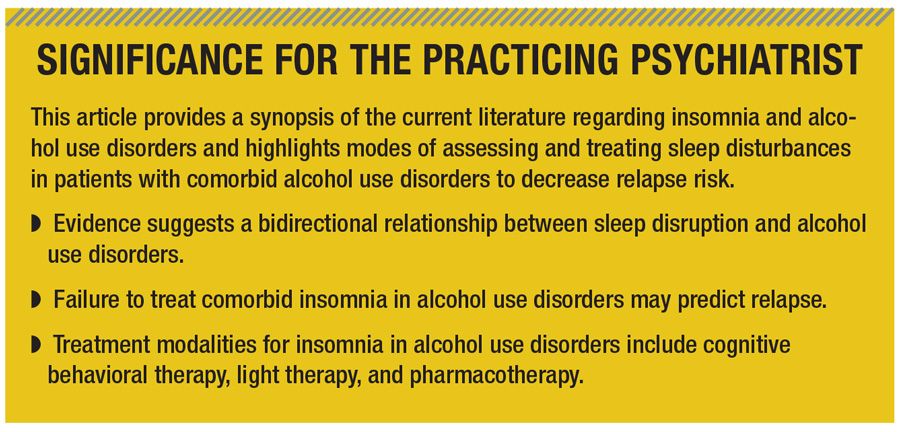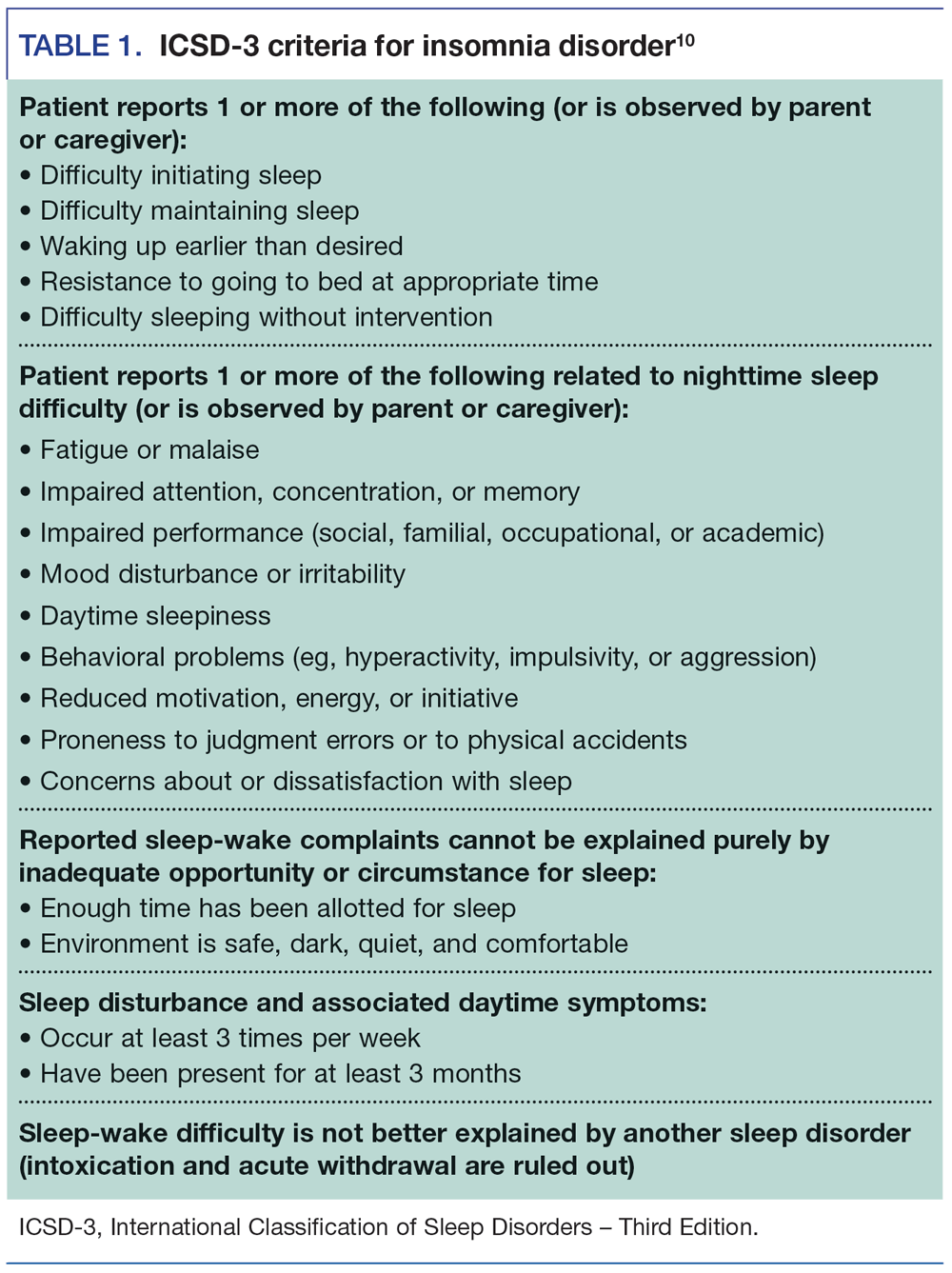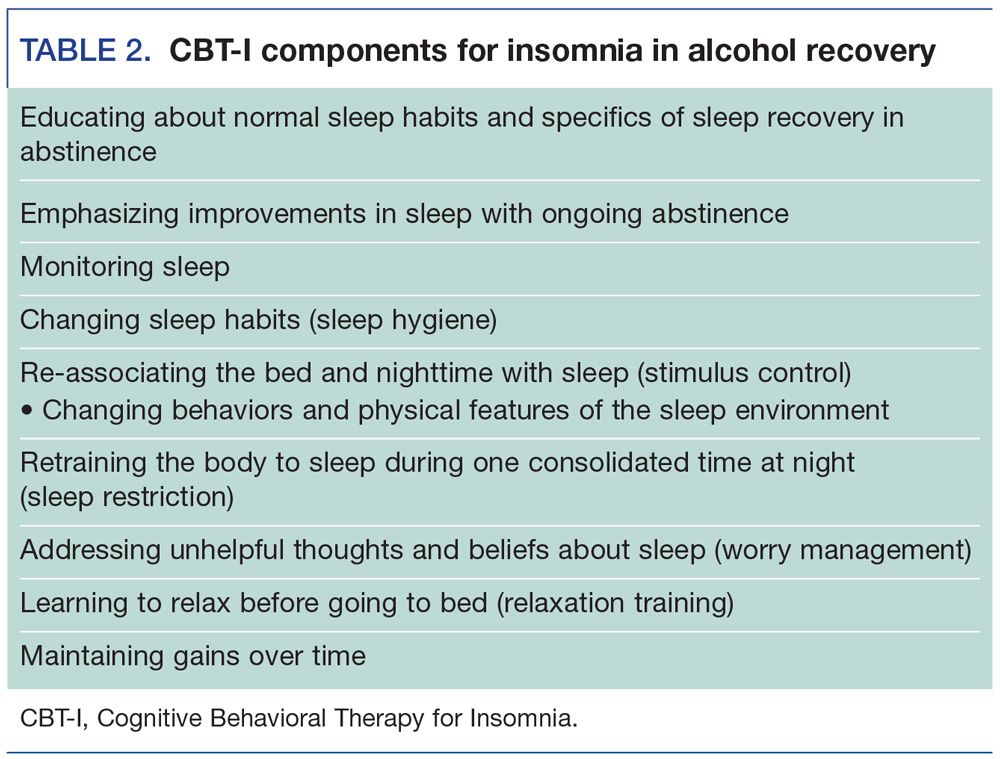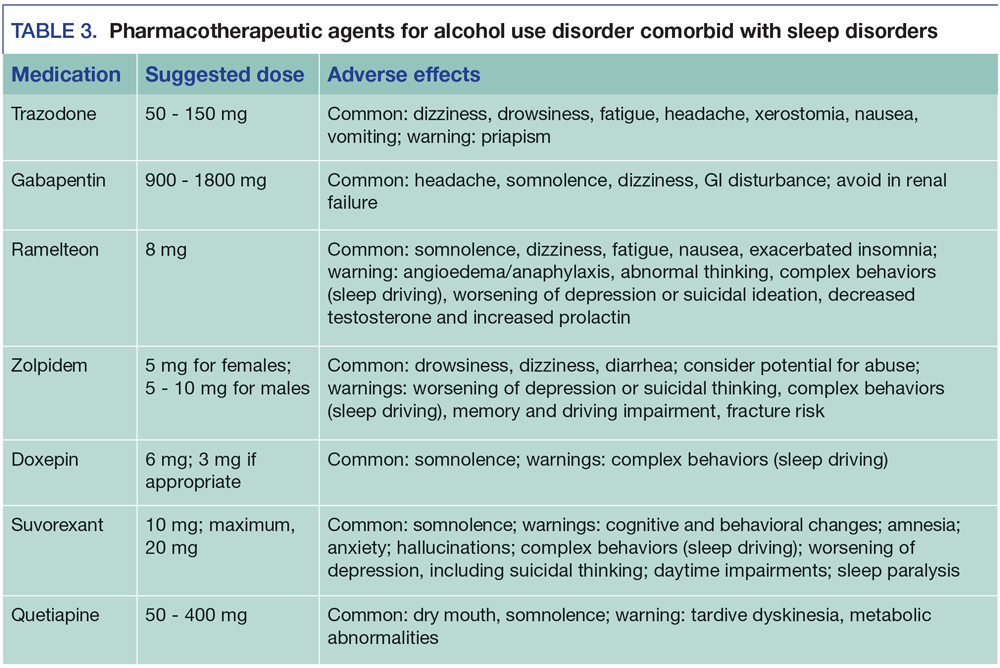Publication
Article
Psychiatric Times
Understanding and Addressing Sleep Disruptions in Alcohol Use Disorders
This article reviews current literature on insomnia and alcohol use disorders and highlights assessment and treatment of sleep disorders in patients with comorbid alcohol abuse.

TABLE 1. ICSD-3 criteria for insomnia disorder [10]

TABLE 2. CBT-I components for insomnia in alcohol recovery

TABLE 3. Pharmacotherapeutic agents for alcohol use disorder comorbid with sleep disorders

Dual diagnosis is a term commonly employed in substance use disorder (SUD) treatment. What is less recognizable is the concept of disturbed sleep as a co-occurring disorder in need of management.
As is the case with affective and anxiety disorders, a growing body of evidence is emerging that SUDs share a complicated relationship with sleep that is bidirectional. Findings suggest that a history of baseline insomnia may be predictive of disordered substance use.1,2 It is also interesting that abstinent adolescents with a family history of substance dependence are more likely to experience difficulties sleeping-a fact that may illustrate psychosocial factors or the presence of a genetic association between sleep and SUDs.
Recent evaluations indicate that polymorphisms of clock genes elucidate this association. Clock genes encode for proteins that form part of an auto-regulatory feedback loop that cycles over a 24-hour period. Variations in certain Clock genes appear to influence sleep drive and circadian preferences; one such gene, PER 3, has been linked to insomnia severity in alcoholic patients.3 New frontiers in addiction research have also implicated neuropeptides such as orexin in the dual role of sleep and reward circuitry.4 The lateral hypothalamus contains many of the neurotransmitters and neural networks involved in alertness, concentration, mood, and regulation of the sleep-wake cycle; many of these networks extend to the reward center that is manipulated by substances of abuse.
Related content.
Mini Quiz: Alcohol and Sleep
It may not come as a surprise that while 10% to 15% of the general population experiences insomnia, reports for subjects with active alcohol use disorders and comorbid sleep disturbance range from 30% to 80%.5 Sleep disruption complicates acute withdrawal as well-upwards of 50% of patients report sleep disturbance during acute withdrawal from alcohol.6 Sleep disturbance in early recovery also represents a formidable obstacle for patients with alcohol use disorder; a subset of patients experiences first-episode insomnia with sobriety. While recovery of restorative sleep is possible with sobriety, it has been suggested that disordered sleep may persist for years in people with a history of chronic alcohol use and increases vulnerability to relapse.
Sleep disturbances and relapse risk
Users who perceive their substance of abuse as soporific may be at increased risk for sleep disturbances and relapse. This perception may be based on early experiences of the substance, when moderate use of alcohol may indeed have conferred subjective sleep benefits such as reduced onset to sleep. A recent analysis that looked at the link between sleep disturbance and alcohol relapse in a residential treatment facility suggests that patients who reported use of alcohol as a sleep aid were more than 3-fold more likely to relapse at 12 months (odds ratio [OR] = 3.26; 95% confidence interval [CI] = 1.33-7.95; P = .008).7 Study findings also indicate a significant association between patients’ use of hypnotics at admission and alcohol relapse at 12 months (OR = 4.03; 95% CI = 1.63-9.97; P = .002).
Foster et al8 queried alcohol-dependent subjects in an inpatient setting and found a subjective sense of sleep latency to be a predictor of relapse. Other studies also support this association between subjective perceptions of increased awakenings and difficulty falling asleep and relapse risk in early alcohol recovery.
Objective evidence of sleep disturbance exists in alcohol use disorders as well. Polysomnography studies suggest that chronic alcohol use increases sleep latency (defined as the amount of time from lights out to sleep onset) throughout the vacillating stages of use, including active drinking periods, acute withdrawal, post-withdrawal, and early and late recovery. In their review, Angarita and colleagues9 conclude that total sleep time (the amount of sleep in one complete episode of sleeping) is uniformly adversely affected by alcohol in all of its use stages from active drinking to later recovery.
Persons with alcohol use disorders also appear to suffer from slow wave sleep deficits (stage N3), which may correspond to difficulty with learning, memory, and cognitive performance. Use of alcohol results in suppression of REM sleep. Following 2 to 3 weeks of abstinence, there appears to be a REM rebound, which some patients describe as an increase in vivid dreams.
Assessment
Polysomnography for the purpose of diagnosing sleep disorders is not practical for many patients and is unnecessary for a diagnosis of insomnia. A clinical diagnosis of insomnia is obtained by meeting the following criteria outlined by the American Academy of Sleep Medicine10: dissatisfaction with sleep quantity or quality, with one or more of the following symptoms: difficulty initiating sleep, difficulty maintaining sleep, waking up earlier than desired, resistance to going to bed on an appropriate schedule, or difficulty sleeping without parent or caregiver. In addition, the sleep disturbance may cause impairment in social, occupational, educational, academic, behavioral, or other important areas of functioning. These criteria are detailed in Table 1.
Other sleep disorders such as obstructive sleep apnea may co-occur with alcohol dependence and can be differentiated from insomnia by screening for factors such as obesity, hypertension, snoring, daytime somnolence, and retrognathia. Periodic limb movement disorder may disturb sleep and may be more prevalent in chronic alcohol users; it is diagnosed by polysomnography.
Circadian rhythm abnormalities have also been linked with alcohol use disorders. Research has implicated melatonin deficiency and delay as a potential culprit for sleep-onset difficulty. Recovering alcohol-dependent men and women demonstrate lower melatonin levels in early evening and delayed melatonin peaks compared with controls. Although melatonin assays are commercially available, the practical applicability of such investigations in sleep disturbances in alcohol recovery is limited. Insomnia remains the most common sleep disturbance encountered in alcoholics: a good history is the cornerstone of accurate diagnosis.
Treatment
Treatment of sleep disorders in previously substance-abusing patients is complicated. Clinicians remain appropriately circumspect about prescribing medications with potential abuse liability, and sleep disturbance may often be perceived by clinicians and patients alike as a natural consequence of substance withdrawal that should remit in time. Whether sleep disturbance is a residue of substance use or substance use is a consequence of historically complicated sleep patterns is up for debate. What has been shown, however, is that a failure to treat the comorbid sleep disorder may predict relapse.
Nonpharmacological interventions such as cognitive behavioral therapy for insomnia (CBT-I) have been effective at minimizing sleep disturbance in recovery populations and may have positive effects on relapse. CBT-I consists of behavioral and cognitive strategies aimed at improving sleep quality and daytime functioning (Table 2). A benefit of this intervention is its applicability to multiple SUDs and its minimal adverse effects. Limitations may include expense, time commitment, and availability of local qualified clinicians.
Light therapy may be helpful in patients recovering from alcohol use disorders who have circadian rhythm dysfunction. Benefits include ease of use and absence of medication interactions. Adverse effects may include activation with possible mania induction in susceptible patients.
Supplementation may also be considered in the treatment schema for patients with an SUD and co-occurring sleep disruption. It is reasonable to introduce melatonin as a potential intervention for patients with alcohol use disorders who have melatonin deficiencies. Studies that evaluated magnesium supplementation found improved subjective sleep scores and improved sleep latency on polysomnography, with total sleep time gains noted in groups with decreased periodic limb movement symptoms.11,12
Table 3 lists available pharmacotherapeutic agents for alcohol use disorder comorbid with sleep disorders. A 2014 review by Conroy and Arnedt13 noted that gabapentin appeared to be safe and effective for treating insomnia in abstinent alcohol-dependent patients. This was corroborated by a study by Mason and colleagues,14 which showed significant improvement in sleep quality for alcohol-dependent patients treated with 1200 mg of gabapentin daily. Benefits of gabapentin include nonhepatic metabolism and inability to lower the seizure threshold; adverse effects include sedation, confusion, ataxia, and abuse potential.
Trazodone was also shown to significantly improve sleep at doses that averaged 100 mg nightly in a large placebo-controlled trial conducted in alcohol-dependent patients over 24 weeks.15 Although there were some initial concerns about an increased risk of relapse with the use of trazodone, subsequent studies have not borne that out. Benefits include tolerability; adverse effects may include priapism, oversedation, and GI disturbance due to serotonergic effects.
An investigation by Litten and colleagues16 demonstrated improved sleep quality with 400 mg of quetiapine extended release. This study extended earlier findings of Martinotti and colleagues,17 who reported significant correlations between the reduction in alcohol withdrawal and craving scores and HAM-D (Hamilton-Depression screen) insomnia items. Adverse effects include disruption of the metabolic profile, risk of movement disorders, and possible abuse potential.
A multicenter trial of 371 alcohol-dependent patients found a significant reduction in obsessional thoughts and compulsions about using alcohol and a reduction in sleep disturbance with topiramate use.18 Melatonin receptor agonists such as ramelteon and agomelatine have also shown some benefit in sleep improvement for alcohol-dependent patients, although further studies are warranted.13,19 Adverse effects of ramelteon include somnolence, dizziness, fatigue, and nausea as well as complex sleep behaviors such as sleep driving.
Other considerations
The following case vignettes highlight the complexity and individual nuances of patients who struggle with sleep and substances. These cases also illustrate the importance of asking about caffeine, nicotine, and high-sugar food intake in early-recovery patients with persistent sleep disturbance. Future investigations of substance use and sleep should incorporate an analysis of these features, as patients in recovery may exhibit a tendency toward cross-addiction and increased consumption of caffeine, nicotine, and sugar that may affect sleep quality.
CASE VIGNETTES
Mr. P had a history of severe alcohol use disorder with 25 years of sobriety following successful chemical dependency treatment. He had a comorbid chronic insomnia disorder that was responsive to a stable 12.5-mg dose of zolpidem extended release. After his primary care provider retired, a new physician tapered off and discontinued zolpidem. Following several other unsuccessful medication trials and a year of disrupted sleep, Mr. P relapsed to alcohol to help fall asleep. He quickly reverted to previous abusive patterns, and he returned to his second alcohol use disorders treatment. After successful completion of treatment, zolpidem was re-instated and Mr. P has remained sober since that time.
Mr. S had a 10-year history of sleep disturbance and daytime fatigue as well as a history of opioid-use disorder that was in sustained remission. Zolpidem was prescribed to target his sleep disturbance, and within 1 year he escalated the dose to 30 mg nightly. He was referred for chemical dependency treatment for a sedative-hypnotic use disorder, and eventually zolpidem was tapered off. For more than a year, he had persistent sleep disturbance.
Mr. S reported that he was drinking more than 7 caffeinated beverages daily and was chewing 1 can of tobacco daily. He achieved restorative sleep with mirtazapine (15 mg nightly) and gabapentin (300 mg 3 times daily). He was able to taper and discontinue caffeinated beverages and transitioned from chewing tobacco to nicotine gum.
This article was originally published on June 30, 2017 and has since been updated.
Disclosures:
Dr. Schmidt is a Psychiatry Resident, Department of Psychiatry and Psychology, Mayo Clinic, Rochester, MN; Dr. Kolla is Assistant Professor of Psychiatry and Psychology, Department of Psychiatry and Psychology, and Center for Sleep Medicine, Mayo Clinic, Rochester.
The authors report no conflicts of interest concerning the subject matter of this article.
References:
1. Ford DE, Kamerow DB. Epidemiologic study of sleep disturbances and psychiatric disorders. An opportunity for prevention? JAMA. 1989;262:1479-1484.
2. Hasler BP, Martin CS, Wood DS, et al. A longitudinal study of insomnia and other sleep complaints in adolescents with and without alcohol use disorders. Alcohol Clin Exp Res. 2014;38:2225-2233.
3. Brower KJ, Wojnar M, Slwerska E, et al. PER3 polymorphism and insomnia severity in alcohol dependence. Sleep. 2012;35:571-577.
4. Schmidt KA, Ho AMC, Frye MA, Choi DS. Association of plasma orexin A and ethanol-drinking behaviors in pregnant rats. J Alcohol Drug Depend. 2016;4:247.
5. Brower KJ. Assessment and treatment of insomnia in adult patients with alcohol use disorders. Alcohol. 2015;49:417-427.
6. Brower KJ, Perron BE. Prevalence and correlates of withdrawal-related insomnia among adults with alcohol dependence: results from a national survey. Am J Addict. 2010;19:238-244.
7. Kolla BP, Schneekloth T, Mansukhani MP, et al. The association between sleep disturbances and alcohol relapse: a 12-month observational cohort study. Am J Addict. 2015;24:362-367.
8. Foster JH, Peters TJ. Impaired sleep in alcohol misusers and dependent alcoholics and the impact upon outcome. Alcohol Clin Exp Res. 1999;23:1044-1051.
9. Angarita GA, Emadi N, Hodges S, Morgan PT. Sleep abnormalities associated with alcohol, cannabis, cocaine, and opiate use: a comprehensive review. Addict Sci Clin Pract. 2016;11:9.
10. American Academy of Sleep Medicine. International Classification of Sleep Disorders. 3rd ed. AASM: Darien, IL; 2014.
11. Kolla BP, Mansukhani MP, Schneekloth T. Pharmacological treatment of insomnia in alcohol recovery: a systematic review. Alcohol Alcohol. 2011;46:578-585.
12. Buysse DJ, Reynolds DF 3rd, Monk TH, et al. The Pittsburgh Sleep Quality Index: a new instrument for psychiatric practice and research. Psychiatry Res. 1989;28:193-213.
13. Conroy DA, Arnedt JT. Sleep and substance use disorders: an update. Curr Psychiatry Rep. 2014;16:487.
14. Mason BJ, Light JM, Williams LD, Drobes DJ. Proof-of-concept human laboratory study for protracted abstinence in alcohol dependence: effects of gabapentin. Addict Biol. 2009;14:73-83.
15. Friedmann PD, Rose JS, Swift R, et al. Trazodone for sleep disturbance after alcohol detoxification: a double-blind, placebo-controlled trial. Alcohol Clin Exp Res. 2008;32:1652-1660.
16. Litten RZ, Fertig JB, Falk DE, et al. A double-blind, placebo-controlled trial to assess the efficacy of quetiapine fumarate XR in very heavy-drinking alcohol-dependent patients. Alcohol Clin Exp Res. 2012;36:406-416.
17. Martinotti G, Andreoli S, Di NM, et al. Quetiapine decreases alcohol consumption, craving, and psychiatric symptoms in dually diagnosed alcoholics. Hum Psychopharmacol. 2008;23:417-424.
18. Johnson BA, Rosenthal N, Capece JA, et al. Improvement of physical health and quality of life of alcohol-dependent individuals with topiramate treatment: US multisite randomized controlled trial. Arch Intern Med. 2008;168:1188-1199.
19. Grosshans M, Mutschier J, Lederer M, et al. Agomelatine is effective in reducing insomnia in abstinent alcohol-dependent patients. Clin Neuropharmacol. 2014;37:6-8.





